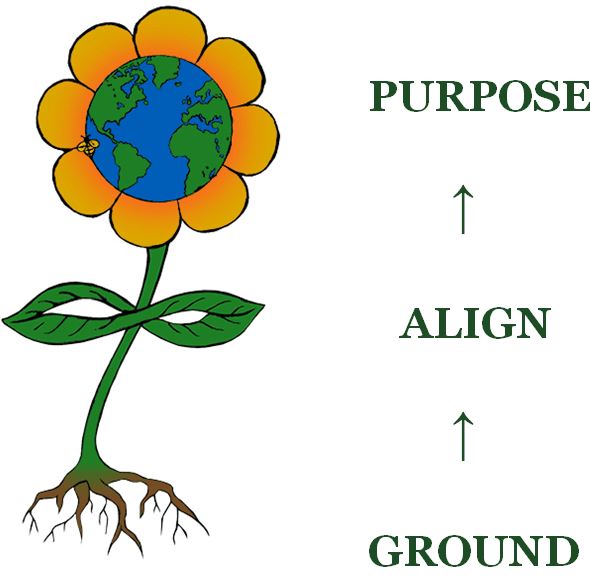A Coaching Model By Cassie Manjikian, Transformational Coaching for Social Change Leaders, UNITED STATES
GAP Ground-Align-Purpose
A transformational coaching model to support social change leaders in being the change they wish to see in the world

The Ground-Align-Purpose (GAP)
Ground
The Ground-Align-Purpose (GAP) transformational coaching model supports social change leaders in connecting and aligning with their purpose, to “be the change they wish to see in the world.” In this time of multiple crises, from systemic racism and climate change to pandemics, many social change leaders face stress, burnout, and trauma which block their ability to be the best version of themself.
Like the model of Appreciative Inquiry – a strengths-based, positive approach to leadership development and organizational change – GAP helps coachees to access their inner wisdom, through a transformational process. Focusing on the “gap” in one’s mindset between their current and desired states of being, the coach helps them to examine their hidden beliefs, values, attitudes, and assumptions, to connect and align with their true self.
Through this whole-person approach, coachees can access new ways of being that are aligned with their purpose, move toward a shifted sense of self, and embody new ways of being that generate their desired results and outcomes. Now more than ever, this transformational coaching approach among social change leaders is a critical way to advance healing, love, and liberation for ourselves, our communities, and the planet.
Ground
During the GROUNDING phase, the coach welcomes the coachee into a confidential safe space of trust and respect, in order to set the stage for transformational coaching. Many social change leaders come to coaching as passionate idealists on the verge of burnout, with multiple layers of witnessed, experienced, and inherited trauma. It’s critical to begin a coaching conversation by calming the nervous system, caring for one’s body, and accessing deep presence and respect for our humanity.
At this stage, the coach supports the coachee with a grounding in their body and roots in their goals for what they’d like to achieve by the end of the conversation or coaching relationship. It’s important for the coach to actively listen with curiosity and empathy, and notice changes in the coachee’s energy, to help them gain an understanding and full awareness of their current and desired essence. Together, they can set goals based on what’s true, and envision their ideal scenario. This phase is represented by roots and the Earth element.
Align
During the ALIGN phase, the coach asks powerful questions that dive below the surface, uncovering core challenges and new possibilities for the coachee to access their inner wisdom. As new awareness begins to take shape, the coach supports forward motion in the coachee’s mindset, closing the “gap” between their current and desired mindset toward authentic alignment with their core self, essence, or inner operating system. With a growth mindset approach, the coach supports the coachee’s exploration of hidden thoughts, beliefs, assumptions, motivations, and values. This process moves them toward a more clear, more conscious, right relationship with their desired new possibilities and ways of being.
Here it can be helpful for the coach to ask about metaphors, visuals, feelings, or physical sensations that arise in their body, and employ tools of powerful listening and relational empathy. This phase is represented by a flower’s stem and the Wind element.
Purpose
During the PURPOSE phase, when the coachee has come to expand or shifted awareness and perspectives, the coach acknowledges, celebrates, and supports them in bravely stepping into their new, purpose-aligned being and embodiment. This may include attending to the structures which underlie their sense of self, identifying obstacles they may need to overcome, naming support and accountability systems, and committing to action steps. The most lasting, sustainable solutions will derive from the coachee’s wisdom, as they access transformed ways of being that will naturally and organically unfold into continued growth.
As the coach closes the session, it is helpful to reinforce the ground covered and goals achieved. Through an open and transparent process of mutual trust and respect, the coach garners feedback on what was helpful, what was challenging, and what they would like to be different in future coaching sessions. Ideally, the client will feel enriched and renewed with healing, resilience, and action steps. This phase is represented by a flower and the Fire/Water element.
Learn How to Create Your Own Coaching Model
Your Coaching Model reflects your values,
philosophies, and beliefs and must communicate who you will coach
and the problems you will solve. Read more about creating your coaching model
